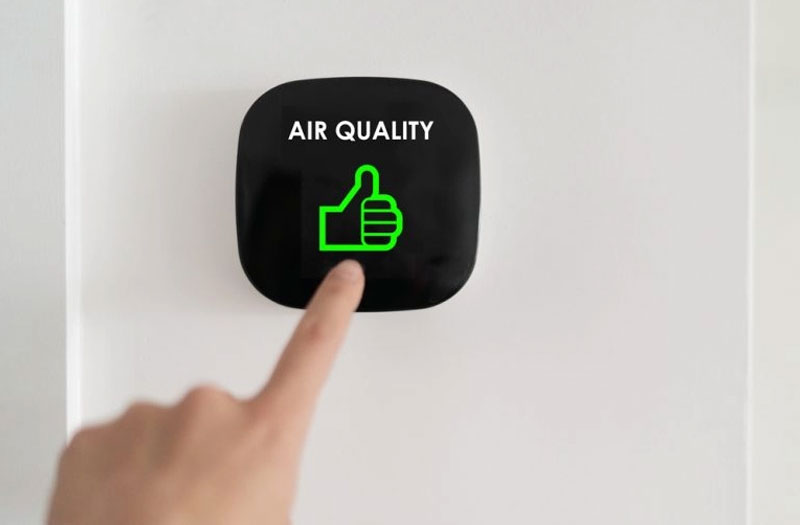
Talk about the modern lifestyle and we can safely say that more than a common man spends more than 90% of his time indoors. Be it the time spent in offices to recreational time spent inside shopping malls, be it time in a hospital to a gym, everything is indoors. One of the most important aspects of indoor hygiene is the quality of air. This aspect largely remains neglected because it is not visible to the naked eye. However, indoor air pollution is real and can have serious health repercussions if not dealt with.
Academics have made startling links between high levels of air pollution and coronavirus mortality rates. The limited research looks at fatalities from the virus and historic levels of dangerous particulate matter known as PM 2.5.
IAQ in a healthcare facility
IAQ inside a hospital or healthcare facility is extremely sensitive. It plays a pivotal role in determining the HAIs and ensuring patient and staff safety. In fact, poor hospital IAQ may cause headaches, fatigue, eye, and skin irritations, and other building-related. The pre-requisite for any hospital facility is to ensure a good IAQ to safeguard patients, nursing staff and visitors from the hazards of occupational diseases and hospital-acquired infections (HAI).
According to the World Health Organization (WHO), at any given point in time, more than 1.4 million people across the globe suffer from a hospital acquired infection. In fact, HAIs account for 2 million cases and about 80,000 deaths a year. Therefore, understanding indoor air quality is a matter of utmost importance for any healthcare facility. Nosocomial infections or HAIs are a major threat to the patients' safety in any health-care facility. However, the prevalence is higher in the Intensive Care Units (ICUs) than other areas of the hospital. This increased prevalence of HAIs influences the mortality and morbidity pattern of ICU.
A detailed study conducted by the International Society of the Built Environment of indoor and outdoor air quality in hospitals revealed the counts of bacteria higher in ICUs and wards namely the orthopaedic ward, neonatal ward, dialysis ward and post-operative ward beyond the recommended levels. The mere presence of fungi in hospital air was a matter of great concern. The high counts were found to be influenced by the activity of ventilation provided.
Sick building syndrome (SBS)
The issue of improving air quality in buildings has often been related to the sick building syndrome (SBS). It is a situation in which occupants of a building experience certain medical symptoms with no specific illness. Symptoms of SBS are acute discomfort, headaches, dizziness, eye, nose, throat irritation, dry cough, itchy skin, nausea etc. Recently many researchers have worked on SBS issue and its effect on office workers and noticed that SBS is not linked to the type of ventilation or air conditioning system used but it is more likely to be a function of how well system are installed, managed and operated. Therefore Operation & Maintenance of HVAC systems in hospitals are more critical than other buildings.
How to improve IAQ in hospitals
- Active Ionisation technology
Active Ionisation technology shows an increased antibacterial power and is proven to be effective against pollen, fine dust, toner, mould, smog, viruses, bacteria and tobacco smoke. These contaminants, depending on their size, can enter the body and damage certain organs. Among the most dangerous airborne substances we find Legionella, a very topical problem that causes millions of deaths every year. With active ionization technology, this problem is eliminated as pollen, dust mites, fungus and other contaminants are captured and inactivated.
The technology is extremely efficient and is proven at removing 98-99% of:
- Airborne bacteria, such as Micrococcus luteus;
- Yeast, such as Rhodotorula rubra;
- Bacillus Anthracis;
- Moulds and germs present in the natural spectrum of air.
Maintaining the humidity levels
The heating, ventilation and air conditioning systems of buildings, including healthcare facilities can nurture the diffusion of airborne substances like Staphylococcus Aureus and Legionella. Infections are also caused by contamination of water supply networks, sanitary appliances, oxygen therapy equipment, fountains and ultrasonic humidifiers.
Improving the standards of indoor air quality has always been a necessity, in fact, the ‘Sick Building Syndrome’ has been an issue for years. Buildings play a role in the spread of disease, which is evidenced throughout history with the SARS epidemic and measles to name a few.
A question of survival
The need for high levels of indoor air quality is nothing new. However, is becoming even more urgent as the world looksto adapt through the global pandemic. Speaking of the UAE, improving air quality has been on the government’s agenda for a long time. The Ministry of Climate Change and Environment works with its partners in the public and private sector to improve the national standards for air pollution and compliance control.
The UAE has been consistently monitoring outdoor air through the UAE Air Quality Index but indoor aur quality matters equally.
We need to look more closely at indoor air quality in the UAE. The Dubai Municipality standard for indoor air quality stipulates that the air needs to have less than 0.08 parts per million of formaldehyde, less than 300 micrograms of total volatile organic compound and less than 150 micrograms of suspended particulates in an eight-hour window of continuous monitoring pre-occupancy.
These standards need to be continuously enforced in a strict manner and include stipulations for PM 2.5. Each facility needs to be aware of these standards and devise strategies and action plans to achieve them. This includes healthcare, retail, commercial and even residential buildings.
It is extremely important to take a step forward and upgrade the standard for indoor air quality in the UAE to a standard recommended by the Eurovent Association (EN16798-3 Sup 2) that calls for lower concentrations of PM in the air. This standard should be made mandatory and can be achieved by installing the right ventilation and ductwork systems in our buildings.
Call for better ventilation
Air ventilation systems have a pivotal role to play in determining the quality of indoor air. The right ventilation system can lower the collection of particulate matter by preventing fungal, mushroom and mould growth which can travel inside the building.
Long-term consequences of poor IAQ are dire. As people are becoming more and more aware of heightened levels of hygiene, they also have a right to know more about the indoor air quality of the buildings they live and work in, especially in schools and hospitals.
In fact, many countries have a national rating system for the indoor air quality whereby developers and landlords can certify that the quality of indoor air in their properties is compliant with the national standard. Steps like these go a long way in ensuring that a common man is safe and healthy.

.jpg)
.jpg)
 Search
Search.jpg)
